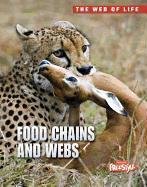-
Food Chains and Webs
Holly Wallace
Paperback (Heinemann/Raintree, April 1, 2003)None Q
Q
-
Food Chains And Webs
Holly Wallace
Paperback (Heinemann, Aug. 1, 2006)Wallace, Holly V
V
-
What Do You Know About Food Chains and Food Webs?
Suzanne Slade
Library Binding (Powerkids Pr, Jan. 30, 2008)Provides information about food chains and food webs using a question and answer format, discussing such topics as the roles and functions of herbivores, predators, and scavengers. O
O
-
Food Chains and Webs
Richard Spilsbury, Louise Spilsbury
Hardcover (Heinemann Library, June 10, 2004)None P
P
-
Food Chains and Webs
Holly Wallace
Library Binding (Heinemann/Raintree, Jan. 1, 2001)Explains how animals living together in certain areas are connected by what they eat, and describes how plants sustain all animals and humans despite plants' ability to hide and protect themseslves. W
W
-
Food Chains and Webs
Holly Wallace
Library Binding (Heinemann, Aug. 1, 2006)Did you know that all food chains start with a green plant? Discover how plants and animals in a particular habitat are linked together by what they eat. Explore the fascinating world of living things, including the processes that keep animals and plants alive, and how people study them. Fact boxes that introduce the most amazing plants and animals are featured in this book along with colorful photographs that show the incredible diversity of life. This book includes a glossary and resources for further research. X
X
-
Food Chains and Webs
Andrew Solway
Library Binding (Raintree, Jan. 1, 2012)Food Chains and Webs explains that feeding relationships are at the heart of life on Earth. It looks at the different types of living things in a food web - from producer to top consumer - as well as food pyramids and topics like bioaccumulation. It tackles common confusions about the science and shows how topics are relevant to the reader.
-
Who eats what?: Food chains and food webs
Patricia Lauber
Paperback (Scholastic, Aug. 16, 2002)An award-winning author and artist explain how every link in a food chain is important because each living thing depends on others for survival. "Clear, simple drawings illustrate the clear, simple text. Informative and intriguing, this basic science book leads children to think about the complex and interdependent web of life on Earth."'BL. Outstanding Science Trade Books for Children 1996 (NSTA/CBC) M
M
-
Food Chains and Webs
Andrew Solway
Library Binding (Raintree, Jan. 1, 2012)Food Chains and Webs explains that feeding relationships are at the heart of life on Earth. It looks at the different types of living things in a food web - from producer to top consumer - as well as food pyramids and topics like bioaccumulation. It tackles common confusions about the science and shows how topics are relevant to the reader. W
W
-
Food Chains and Webs
Holly Wallace
Paperback (Heinemann Intl Inc, Sept. 30, 2007)None N
N
-
Exploring Food Chains and Food Webs
Ella Hawley
Library Binding (Powerkids Pr, Aug. 15, 2012)Food chains and webs are important representations of the predator-prey relationships that all living things are a part of. Readers will learn about the food chains and food webs in a variety of habitats in this volume, how everything is connected, and how every living organism plays a role. Kids will be drawn in by the colorful nature photography, while simple graphic organizers help them to understand the many roles that living organisms play. M
M
-
Exploring Food Chains and Food Webs
Ella Hawley
Paperback (PowerKids Press, Aug. 15, 2012)Food chains and webs are important representations of the predator-prey relationships that all living things are a part of. Readers will learn about the food chains and food webs in a variety of habitats in this volume, how everything is connected, and how every living organism plays a role. Kids will be drawn in by the colorful nature photography, while simple graphic organizers help them to understand the many roles that living organisms play. M
M